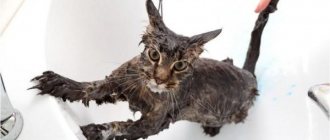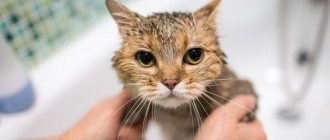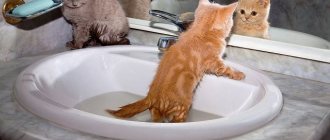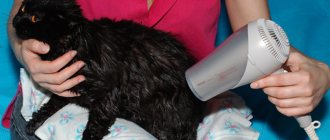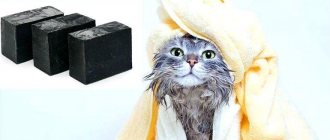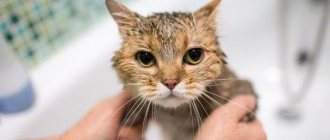Despite the fact that cats are one of the cleanest animals, there are times when a pet needs to be bathed. Many cats have a fear of water, which often causes their owners to suffer. Scratched, bitten hands, damaged interiors and household items are some of the most common consequences of bathing cats. To avoid such troubles, you need to know how to properly wash cats and kittens.
Cats are naturally very clean and take care of their fur on their own. Every day you can watch her wash herself, lick her fur and paws. But sometimes this is not enough. Incidents can happen not only with street cats, but also with indoor cats. And then the need arises to wash the cat.
If the cat's fur or paws are slightly dirty, the dirt can be removed without resorting to water procedures. Just wet the towel and wipe the fur and paws to remove dirt. But if the cat’s fur is thoroughly dirty, then bathing cannot be avoided.
The question often arises, how often can you bathe a cat? If the cat is domestic, then it can be bathed once every 3 months. Cats and kittens that walk outside should be taken no more than once a month.
What determines how often you can wash your cat:
- from age;
- breeds;
- wool length;
- conditions of detention;
- habitats;
- individual characteristics.
But there are always exceptions. There are some cats that love water treatments. Some of them even like to swim. Many owners don't even realize that frequent bathing can negatively affect a cat's health.
Why you shouldn't wash your cat often
During bathing, a special protective layer is washed off. If you wash a cat too often, it does not have time to recover, which causes its immunity to decrease. As a result, the cat becomes more susceptible to various diseases. Also, frequent bathing leads to dry skin and fur, which also affects the health and well-being of the pet.
Among other things, cats are very afraid of water. Water procedures are very stressful for many cats. And any worries and stress reduce the pet’s life expectancy.
Should you wash your cat?
All pets need water treatments throughout their lives. You have to bathe them more than once, as dirt and tangles appear on the fur. But the owner wants to see his pet well-groomed and beautiful.
When should you bathe a cat?
You only need to wash your “cat” in justified situations, for example when:
- The fur is matted and the shine is gone.
- The “mustachioed naughty guy” knocked something over on himself, or climbed into something.
- If there are fleas. After bathing, treatment should be carried out.
- When there are signs of an allergic reaction, lichen, dermatitis and other skin diseases.
- A homeless “fluffy” was brought from the street.
- In preparation for the exhibition.
Some medical cases require a doctor's prescription.
Cleanliness is in the blood
Cats are naturally clean
Cats are naturally clean. Hygiene is important for health and well-being. Animals lick their fur every day and groom themselves. Mothers lick their babies' fur to keep them clean. But this is not enough for cat hygiene. Bathing is necessary to cleanse your pet of dust, debris and dirt. Cats carry all this dirt from the street into the house.
Twice a year, the cat begins to shed seasonally. During these periods, hair begins to fall out more often than usual. During the hygiene procedure, cats accidentally swallow hair that ends up in the cat's stomach. You will be lucky if the animal regurgitates its fur; in the worst case, intestinal obstruction may occur.
Animals can also become infected with fleas, so you need to bathe your cat with a special shampoo.
How often should you bathe your cat?
How often can cats be bathed is of particular interest to pet owners. There is no need to arrange a bath day every week; it is recommended to do this once every 2-3 months. The little predator is used to keeping its fur clean. Frequent baths can be harmful, as the protective lubricant produced by special glands is washed away.
It is important to separate the need for thorough washing of the pet and partial wiping of contaminated areas. If the cat gets his paws dirty in the litter box or returns from a walk, you should simply remove the dirt with a warm, damp cloth. You can use liquid baby soap, previously dissolved in water.
When it's snowing and cold outside
photo from the site: VashiPitomcy.ru
Now about whether it is possible to bathe a cat in winter and how to do it. You shouldn’t completely forget about bath procedures, but it is necessary to reduce their number. That is, we don’t let the animal become covered in dirt, but we also don’t wash it more than once every four months.
At normal temperatures in the apartment, it is enough to wipe the animal dry by wrapping it in a towel. To speed up drying, you can turn on a hairdryer. The main requirement for winter swimming is no drafts.
How to teach a cat to bathe
To prevent your pet from being stressed, it is necessary to accustom him to water in stages; it is better to start from an early age. It is not recommended to wash kittens until their permanent teeth appear. First, you can dip your paws in warm water. You can wash it for the first time 3 weeks after changing teeth. You need to let the animal adapt, you can’t rush. Babies are not as clean as their “moms” and “dads”; a kitten can get dirty due to its curiosity. In this regard, the recommendations of veterinarians say: - Young animals should be bathed as their fur becomes dirty.
Process Features
In order to wash your cat correctly, you will need to know a few secrets:
- It is prohibited to use products intended for people (so as not to violate pH values);
- Zoo shampoos can be in liquid or dry form, as well as in spray form, so the application process can be made as quick as possible for the animal.
© shutterstock
A British cat or any other cat should be bathed directly in warm, but not hot, water. You will first need to comb the coat to get rid of tangles or loose hairs. You should wash your pet briefly, without sudden movements. It is also very important to ensure that water does not get into your ears. For this purpose, you can purchase special plugs.
It is not recommended to wash a pregnant cat, as this process can cause stress to her.
In order to ensure the safety of the animal, you should place a rubberized mat on the bottom of the bathtub - this will prevent your paws from slipping. Wash with shampoo for no more than 1-2 minutes after applying the composition to the coat.
After completing the main process, you will need to blot the wool with a warm towel to get rid of excess water. It is not recommended to use a hairdryer, as it can frighten the animal (especially if it is a kitten).
How to properly wash a cat
You need to prepare a large towel and detergent in advance. It is advisable to remove all unnecessary objects from the bathroom, close the door and window from drafts.
The washing itself should take place at a comfortable temperature - about 35-37 degrees. If your pet is very hot or cold, he may get scared, especially if he is afraid of water. Fill the bath to 20-30 centimeters, slowly lower the animal into it. It is recommended to take it by the withers, there is a pain-free zone. Next, thoroughly wet the skin, making sure that water does not get into your eyes, nose, or ears.
Squeeze a little shampoo into your palm, then lightly massage the fur with rubbing movements. It is allowed to use a soft brush. It is more convenient to bathe a domestic cat using a shower hose with a gentle pressure of warm water. If necessary, you can soap again. Then rinse the fur thoroughly to remove any remaining detergent and dry the animal well.
Leave a request for a cat hotel
Optimal water temperature
It is very important to prepare comfortable water for bathing your pet. You must adhere to the following rules:
- very hot water can burn delicate skin, it would be correct to set the indicator to 40 degrees (depend on the breed). If your pet is trembling, it means the water is too cold for him;
- The room where the cat will take a bath should be warm, at least 23 degrees Celsius. To determine the temperature, be sure to use a thermometer, not your palm or elbow.
Contraindications for swimming
There are cases when washing pets is prohibited:
- in the postoperative period. Full recovery usually takes a month or a month and a half;
- in the late stages of a cat's pregnancy. You should not wash her at this time, stress can cause premature birth;
- after vaccination, within 14 days. Veterinarians believe that immunity is weakened at this time;
- When an animal is sick, washing can make the condition worse.
If the pet owner is concerned, water treatments should be canceled.
Drying wool after bathing
A washed animal should be wrapped in a terry towel or sheet. For long-haired breeds, prepare an additional diaper to completely absorb moisture. You can dry the fur with a hairdryer if sharp sounds do not frighten the “murka”. It is better to set the device to a warm air supply; a very hot flow can cause burns. To prevent the animal from catching a cold, there is a condition - you need to leave it for 1 hour in a warm room.
How to wash your cat's eyes and ears
Accumulation of wax in your pet's ears is normal. No need to try to pick it out all the time. This procedure is carried out once a month. For cleaning, a special gel is used; it is instilled into each ear according to the instructions. The dirty flakes will flow out after a while. Then the owner can wipe the inside of the sink with a piece of gauze bandage. If the animal is nervous, you should wait rather than force it into an unpleasant operation.
There is no need to clean your eyes unless necessary. This should be done when the “purr” has excessive lacrimation or suppuration in the eyes. You can buy drops at a veterinary pharmacy; they are calculated in the required dosages. It is also permissible to use furatsilin at home - 0.02% aqueous solution (1 to 5). Moisten a sterile napkin with the medicine and wipe the eyes of your furry friend.
Choosing a bathing temperature
Is it possible to feed a cat both dry and wet food at the same time: examples of mixing
Before holding events, you need to pay attention to the following points:
- how many degrees in the room - in the bathroom and the room where the cat will dry, it should be at least 22 degrees;
- water - from 38 to 40 degrees, depending on the breed.
You can determine the comfort of the temperature by looking at your pet - if he is shaking with chills, then he is cold. Too hot water can cause serious burns to delicate skin; its readings should not exceed 40 degrees.
Features of washing cats of different breeds
There are exceptions to any rule.
Hairless and long-haired cats often need a water procedure. The skin of sphinxes, for example, produces a lot of oil, how often should it be washed then? To prevent blockages of the glands, it is recommended to arrange water procedures as dirty plaque appears in the folds of the skin. Scottish Folds do not need to be bathed at all, it all depends on the condition of the pet. Obese individuals should be helped to maintain hygiene as they may not be able to reach certain areas of the body to lick themselves. In such cases, it is advisable to combine bathing cats with physical movements.
And some more tips on washing cats
- Do not bathe a pregnant cat or if she is nursing kittens.
- An adult, unneutered cat needs more frequent washing. Due to the secretion secreted, his fur gets dirty faster, becomes greasy and sticks together.
- At least two weeks must pass after the operation, and only then can the animal be bathed.
- If you adopted a pet from a shelter, you should not wash it in the first few days. Moving and swimming together is incredibly stressful.
- During the shedding period, washing helps to quickly get rid of dead hairs.
- Do not wash your animal while it is sick.
So, the frequency of bathing is a conditional indicator. It depends on the cat’s cleanliness, the characteristics of its lifestyle and conditions of detention. An attentive owner will always understand that his pet needs additional care and will carry out water procedures with maximum comfort.
What you can and cannot wash your cat with
For water treatments, it is important to choose the right shampoo that fully meets the needs of the animal and will provide coat care. You need to take great responsibility when choosing a hygiene product, taking into account all the features, the breed of the cat, problems, if any.
It is strictly forbidden to wash your pets with your own shampoo; if you do this, you can provoke an allergy. You need to purchase bathing products from veterinary pharmacies and special pet stores. There you can get a guarantee that all products are certified and of high quality.
Which bathing product should I choose?
Detergents are available in the form of: dry powders, gels, sprays. Today it is popular to wash domestic cats with liquid products. Shampoos are divided into the following areas:
- Cosmetic. They are used in cases where during bathing it is necessary to wash away dirt from the animal’s fur.
- Medicinal. They destroy insects, relieve lichen, skin rashes, and so on. Be careful, it contains an insecticide, read the instructions carefully!
- Antibacterial. Usually contain an antiseptic component. Thanks to it, a bacterial infection can be cured.
- Special (decorative) products. They are used to tint the fur of mustachioed fashionistas. You can purchase this washing shampoo for cats with different coat colors. It adds shine, a beautiful shade, and volume.
What you need to bathe cats
Human shampoos are not suitable for washing. The pH of human and cat skin is different. The wrong cleanser can lead to dry skin, dandruff and even ulcers.
To bathe, you must purchase a special shampoo for cats in advance. If your pet has fleas, the detergent should have an antiparasitic effect.
Water temperature is about 37 C°. You will also need two towels to catch the water from the wool.
If your animal is terribly afraid of water, it is better to buy dry shampoo. The powder is applied to the coat and then combed out. It will collect dirt and grease, and also maintain friendship between the cat and the person.
Short-haired cats can be wiped with a wet towel. It will remove dirt and loose hair.
Bathing a cat before a show
Demonstration performances in such events require the ideal appearance of the pet. Before the exhibition, it is advisable to wash it with pet shampoo. Comb the wool, lay it with colorless gel and fix it with varnish. Owners often ask whether it is possible to wash a cat with human toilet soap. Here the answer is clear - under no circumstances! The soap has an unsuitable pH (acid-base balance) for the animal, and there is a risk of massive hair loss and partial baldness. Then you will have to give up the competition.
Of course, some pets live without water treatments and are quite happy. However, there are situations when you cannot do without a good bath. Let your four-legged friend's bathing always take place in a calm environment. Show the cat that you can be trusted, give him a treat and everything will go well.
We hope that we were useful to you, we are always glad to see you in our hotel for cats and cats, Cat Lounge
When is swimming contraindicated?
It happens that bathing a pet is prohibited. It is important to know the contraindications when you can’t wash your cat?
Vaccinations
You should not wash your cat before vaccination.
When your baby needs vaccinations, you need to know some things about washing. You cannot bathe the animal before vaccination, because... They are done only on dry skin. It is worth holding off on the procedure or rescheduling your visit to the doctor to another day, when the baby’s coat is dry.
After vaccination, it is forbidden to wash the animal for 5-7 days, and sometimes for two weeks. However, all situations are individual. Ask your doctor for advice on when and how often to bathe.
Pregnancy
Carrying children is a lot of stress for a cat. A mother gives all her energy and strength to her babies. Animals do not like to bathe and experience fear during the procedure. It is not recommended to bathe a pregnant cat to avoid stress. On the contrary, it is worth creating comfortable conditions and a calm environment for her.
It is not recommended to wash a pregnant cat
After giving birth, you should also not wash the animal for a while. If the cat gets dirty, you can wipe the body with wet wipes or a wet towel.
Sterilization
After sterilization, you should take a break and not bathe your cat for one week, because... there are seams. It is advisable to ask your veterinarian when you can resume bathing procedures.
It is not advisable to bathe sterilized cats.
Diseases
If your pet is sick or not feeling well, do not allow situations in which the animal feels stressed. Wet skin prevents wounds from healing.
Exception: sometimes during illness a pet develops different discharge. Then you will have to bathe the sick baby.
Can I use human shampoo?
Bathing a pet ensures not only its hygiene, but also the cleanliness of the room - after all, living nearby, we inhale the same air, touch the same objects, and maintaining cleanliness is necessary not only for beauty, but also for health. One of the most important things in keeping pets is grooming, which means weekly brushing and monthly washing.
Many dog owners have a lot of questions about this: what and how often can they wash their dog so as not to harm its health, is it possible to wash the dog with human shampoo, baby, tar and laundry soap, how to wash the dog correctly, and so on. We will try to answer these and other questions in this and other articles dedicated to caring for your four-legged pet.
It is enough to wash our short-haired four-legged friends no more than three times a year, because their skin and coat have a natural protective “lubricant”.
Frequent bathing can damage the skin by stripping away its natural protection and causing dandruff and dry skin. After walks, you can limit yourself to washing your paws or cleaning them with wet wipes .
It should be noted here that simple splashing with water in the form of a game is not considered washing, since no detergents are used and the wool does not get completely wet.
What is the best way to wash animals?
To maintain hygiene, you need to bathe your puppy with special shampoos, divided into several categories.
Pet stores offer a lot of products for caring for the hair and skin of dogs, which sometimes makes it difficult to choose - after all, it is easier to choose something universal that could be used in all cases. But this approach is wrong and cannot be justified by any arguments.
What kind of shampoo
Dogs should be washed with special shampoos designed specifically to care for their skin and coat. The selection of shampoo depends on several factors:
- Breed and age of the dog. There are specially developed products for puppies and older dogs, as well as for large and small breeds;
- The purpose of washing is simple cleaning or getting rid of lice or odor;
- Coat lengths – long-haired dog breeds require products that not only cleanse, but also soften the coat, making it easier to comb and giving it shine (this effect can be achieved by additionally using balms and masks). For example, owners of poodles should choose shampoos that prevent matting, while owners of dogs with white fur are recommended to use bleaching products.
It should be noted right away that you cannot use human shampoos or soaps, because the acid-base balance of human and dog skin is very different and shampoos intended even for delicate and sensitive human skin can harm the pet.
For complete care of your pet, it is recommended to purchase several types of shampoos - for weekly use, against fleas, dandruff and odor. And now more details.
Selection of shampoo by breed and coat type
The coat of long-haired dogs requires more careful care - washing with shampoo, rinsing with a special anti-tangle balm, etc., while short-haired dogs, for example, need softening and shine-inducing shampoos.
White wool quickly fades, acquiring a gray tint. Dogs with white coats require bleaching products. They are also suitable for light-colored dogs, giving the coat a silvery tint.
Chocolate or black coats may lose pigmentation and become dull and unattractive. For such cases, tinted shampoos are recommended, which, having a gentle effect, have a fairly long-lasting effect, saturating the animal’s fur with the necessary pigments.
Shampoos for dogs prone to allergies should be colorless and odorless. It is recommended to contain aloe vera with a moisturizing and protective effect.
By purpose of destination
Depending on the purpose of use, you can choose specially designed shampoos against:
- Fleas and lice;
- Dandruff and itching;
- Other skin diseases;
- For frequent use.
For preventive purposes or if necessary, you can use special anti-flea shampoos. They do an excellent job of killing not only adults, but also their larvae. Such funds, after some time (usually 10-14 days), are reapplied.
Detergents containing chlorhexidine have also been created, which effectively eliminates itching. Shampoos that combat the typical odor of dog hair are widely used. To prevent your dog from smelling like “dog,” use them periodically.
Washing without water
In some cases, when it is not recommended or undesirable to wash dogs, or simply if there is no shampoo, but you need to quickly tidy them up (for example, before a show) or wash off dirt during the post-vaccination period, you can use dry shampoos that do not require the use of water.
The powdery consistency of these products allows them to quickly absorb into the animal’s hair and remove dirt, followed by combing the hair.
The use of dry shampoos is also convenient in cold weather, when you do not want to expose your dog to the risk of catching a cold.
Examples of proven tools
On the Russian market you can find a lot of shampoos and other detergents for dogs - a short review will help you make your choice. Hygienic shampoos perfectly cleanse dirt from your pet’s skin and fur. Recommended:
- Mr. Bruno with celandine;
- Milord and "Doctor ZOO" for long-haired dogs with provitamins and keratin;
- “Sea” for wire-haired dogs with chitosan and provitamins.
You can choose from therapeutic options:
- SPA Comfort for problem skin;
- "Tropiclean" for itching and dandruff;
- Hypoallergenic "Gentle".
These products eliminate itching, irritation, dandruff, dryness, and brittle hair.
To eliminate unpleasant odors, tangles and make combing easier, you can purchase shampoos with conditioners, such as ROLF CLUB. And Beaphar “Bea Flea” and “Bingo” shampoos are excellent in the fight against fleas.
Tinted shampoos “White Pearl” and “Black Pearl” from the company “8 in 1” will perfectly highlight the natural color of your pet’s coat, making it more saturated and shiny.
Among dry shampoos, we can recommend Bea Grooming Powder, Elite spray with allantoin, cleansing and degreasing Dry Cleaning Secco from the Italian company Cliffi.
What not to wash
There is an opinion that you can wash your pets with anything, any ordinary shampoo, just to restore cleanliness and order. But is it? It has already been said above why dogs should not be washed with shampoo intended for humans. It should also be noted that children's products are not suitable for this role.
Scented, laundry or tar soaps dry out your pet's skin and have an unpleasant odor, so they also cannot be used for washing.
Cat shampoos, although designed for pets, are not suitable for dogs. It’s another matter if it is a combined product that allows it to be used for both cats and dogs without harming their health.
How to clean paws and ears
After walks, it is advisable to clean the animal’s paws of dust and possible contaminants. In order not to bathe them every time after a walk, you can use special shampoos for paws - “Doctor ZOO”, “Gulena”, “Four Paws”, “Shoe”.
While bathing, you should not allow moisture to get into your pet's ears, but this does not mean that you do not need to clean his ears. For this we recommend:
- Doctor VIC hygiene lotion, which fights pathogenic bacteria and fungi;
- Dekta-Forte ear drops;
- ear-cleaner lotion from Beaphar, etc.
How to wash your pet during estrus and pregnancy
Water procedures are especially important during estrus and pregnancy. After giving birth, it is advisable to refrain from washing for a week. The choice of detergent is very important. The right shampoo should contain lanolin, egg yolk or lecithin.
When washing during estrus and after giving birth, it is important to wipe the coat dry and protect the bitch from drafts and colds.
Not only the cleanliness and beauty of the coat, but also the health of the pet depends on the choice of shampoo, so it is important to make the right choice and ensure your pet’s health and comfort. Properly selected products for washing and caring for pets speak of love for the pet and the erudition of the owner.
Source: https://pesikmal.ru/uxod/soderzhanie/myt-shampunem.html
How to dry a washed pet?
After bathing, wrap the cat in a thick towel for 10–15 minutes. You will need to change several towels to remove moisture from the wool. The skin of the Sphynx is dried with blotting movements, paying special attention to the skin folds. After this, the surface is lubricated with a special lotion, baby oil or cream to protect it from drying out and cracking. The pet is dried in a warm room, protected from drafts.
After drying with a towel, short-haired cats can be placed near a radiator or on a sunny windowsill. Pets with long hair must be dried with a hairdryer, as they take up to 12 hours to dry, which can lead to a cold. Drying begins from the head, moving along the sternum, front legs, back, hind legs and tail. The hair dryer is used at medium temperature and kept at a distance of 30–35 cm from the coat. After drying, the wool is thoroughly combed with a brush.

